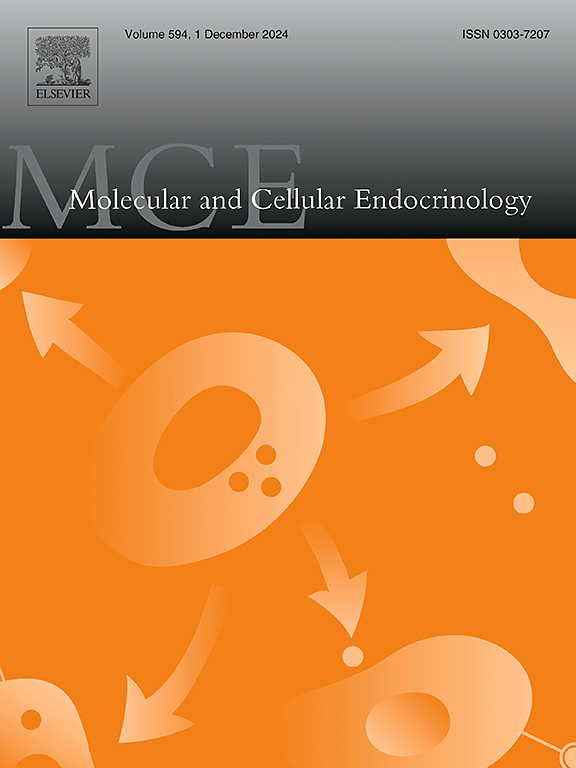高龄产妇诱导大鼠胎盘早期发育中fox01激活改变和细胞衰老。
IF 3.6
3区 医学
Q2 CELL BIOLOGY
引用次数: 0
摘要
高龄产妇(AMA)与不良妊娠结局的风险增加相关,部分原因是胎盘功能障碍;然而,潜在的机制仍然知之甚少。本研究旨在探讨AMA妊娠早期胎盘发育,重点关注FoxO1激活及其在细胞衰老和氧化应激中的作用。方法:3月龄Wistar大鼠(对照组)和10月龄Wistar大鼠(AMA)与年轻雄鼠交配。在妊娠第12天,测定蜕膜和发育中的胎盘中FOXO1的活性及其靶基因的表达、氧化状态和形态测定。结果:AMA大鼠着床部位减少,存活胚胎减少,胚胎冠臀长度减少,表明生长受限。蜕膜氧化应激指标升高。在分子水平上,蜕膜中FOXO1磷酸化水平降低,表明FOXO1活性增加,而在发育中的胎盘中,FOXO1磷酸化水平升高,表明其失活。调节FOXO1磷酸化的激酶SGK1在AMA大鼠蜕膜中显示磷酸化降低。此外,衰老标记Cdkn1a (P21)和Cdkn2a (P16),已知的FOXO1靶基因,在蜕膜中上调,在发育中的胎盘中下调。这些变化与蜕膜细胞增殖受损和发育中的胎盘胞间滋养层减少有关。结论:这些发现强调了AMA妊娠期间蜕膜和胎盘中FOXO1的差异调控。蜕膜中FOXO1活性的增加可能是由氧化应激和SGK1磷酸化的降低引起的,这可能会损害蜕膜的个体功能,并导致FOXO1活性降低而改变胎盘发育。本文章由计算机程序翻译,如有差异,请以英文原文为准。
Advanced maternal age induced altered FoxO1 activation and cellular senescence in early placenta development in rats
Introduction
Advanced maternal age (AMA) is associated with increased risks of adverse pregnancy outcomes partly due to placental dysfunction; however, the underlying mechanisms remain poorly understood. This study aimed to investigate early placental development in AMA pregnancies, focusing on FoxO1 activation and its role in cellular senescence and oxidative stress.
Methods
Three-month-old (Control) and 10-month-old (AMA) Wistar rats were mated with young males. On day 12 of pregnancy, FOXO1 activity and the expression of its target genes, oxidative status and morphometry were evaluated in the decidua and developing placenta.
Results
AMA rats exhibited a reduced number of implantation sites, fewer viable embryos, and decreased embryonic crown-rump length, indicating restricted growth. Markers of oxidative stress were increased in the decidua. At the molecular level, FOXO1 phosphorylation was reduced in the decidua, suggesting increased FOXO1 activation, whereas in the developing placenta, FOXO1 phosphorylation was elevated, indicating its inactivation. SGK1, a kinase that regulates FOXO1 phosphorylation, showed decreased phosphorylation in the decidua of AMA rats. Moreover, the senescence markers Cdkn1a (P21) and Cdkn2a (P16), known FOXO1 target genes, were upregulated in the decidua and downregulated in the developing placenta. These changes were associated with impaired cell proliferation in the decidua and a reduced syncitiotrophoblast layer in the developing placenta.
Conclusion
These findings highlight the differential regulation of FOXO1 in the decidua and placenta during AMA pregnancies. Increased FOXO1 activity in the decidua, likely driven by oxidative stress, and reduced SGK1 phosphorylation, may impair decidual function and contribute to altered placenta development with reduced FOXO1 activity.
求助全文
通过发布文献求助,成功后即可免费获取论文全文。
去求助
来源期刊

Molecular and Cellular Endocrinology
医学-内分泌学与代谢
CiteScore
9.00
自引率
2.40%
发文量
174
审稿时长
42 days
期刊介绍:
Molecular and Cellular Endocrinology was established in 1974 to meet the demand for integrated publication on all aspects related to the genetic and biochemical effects, synthesis and secretions of extracellular signals (hormones, neurotransmitters, etc.) and to the understanding of cellular regulatory mechanisms involved in hormonal control.
 求助内容:
求助内容: 应助结果提醒方式:
应助结果提醒方式:


